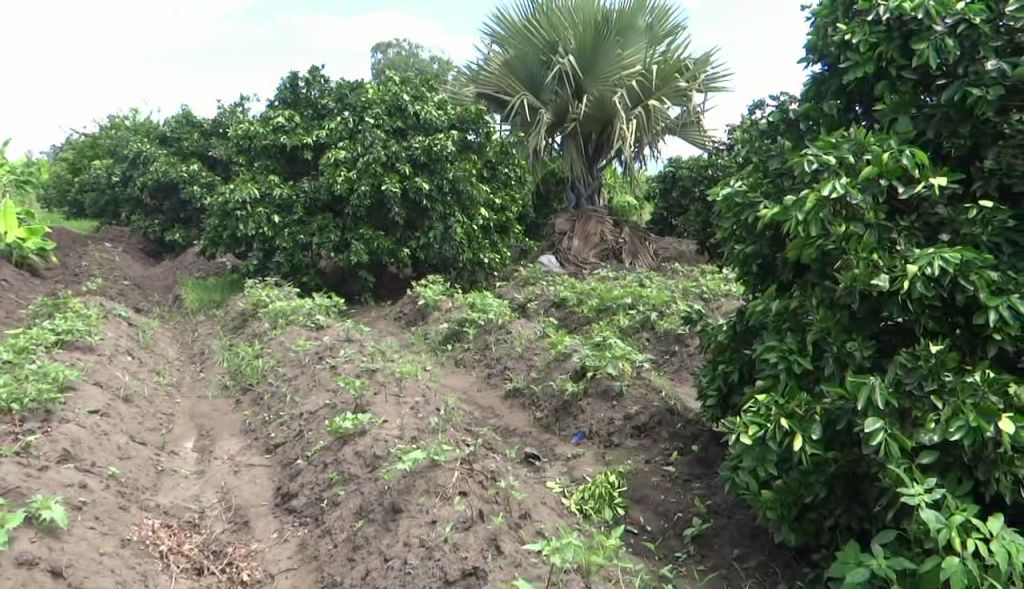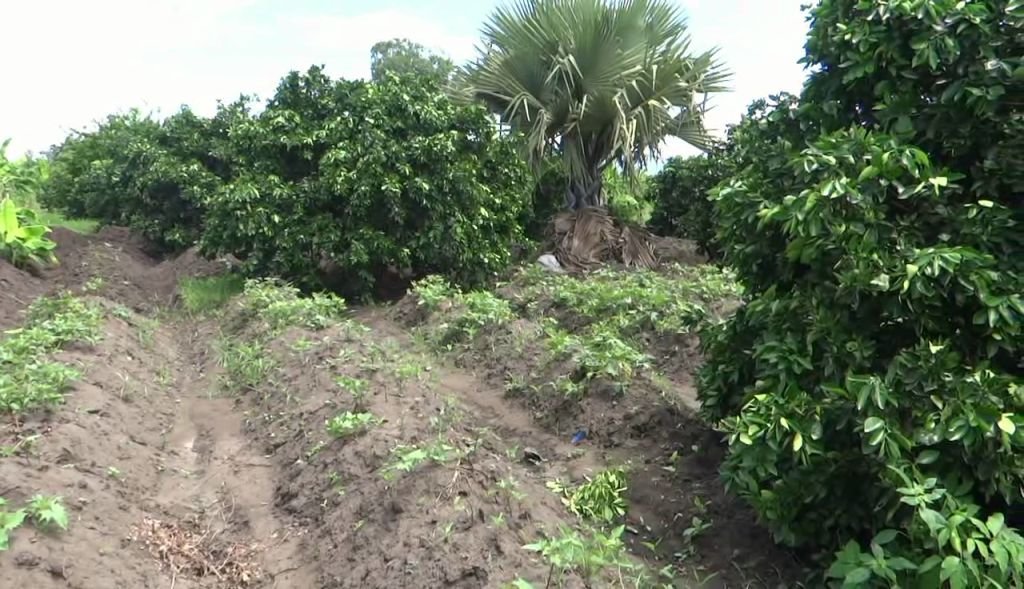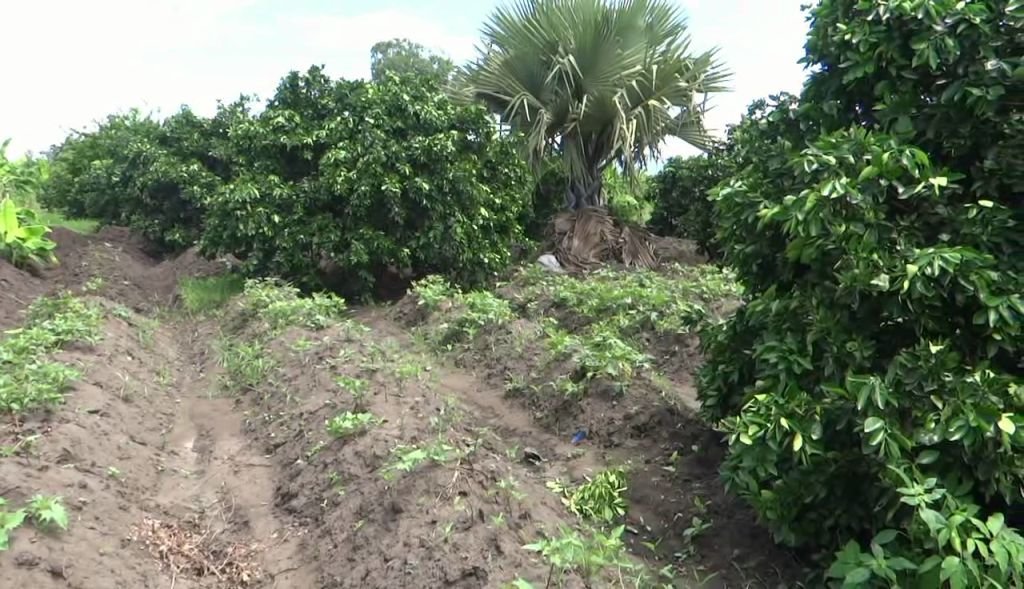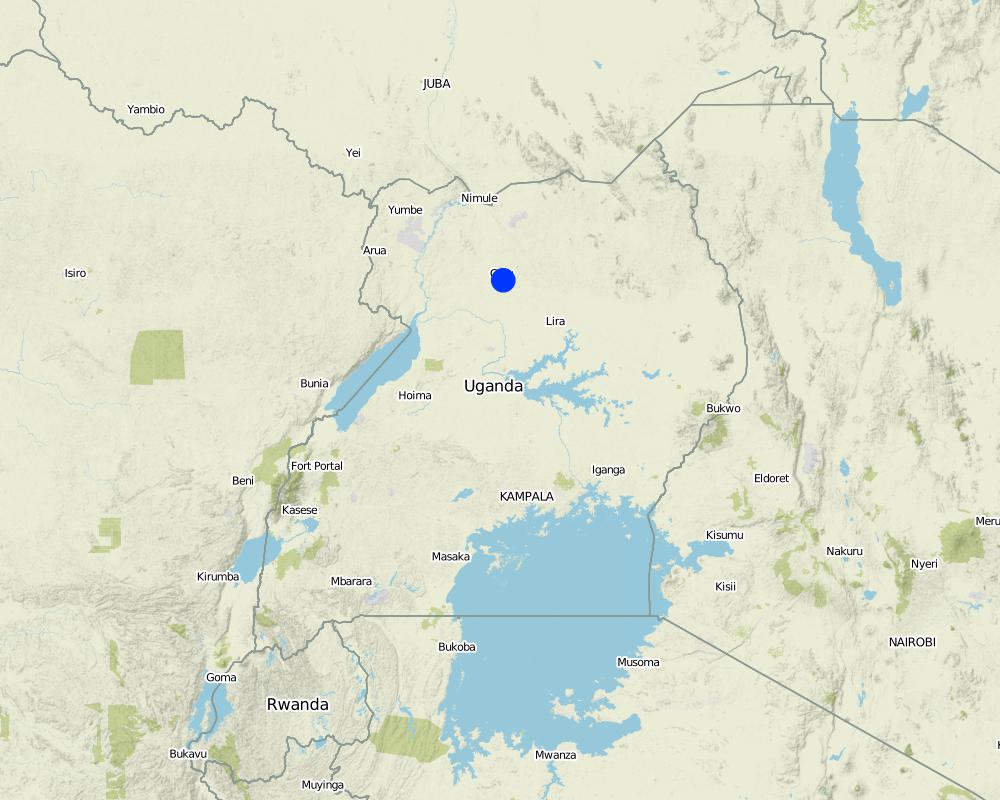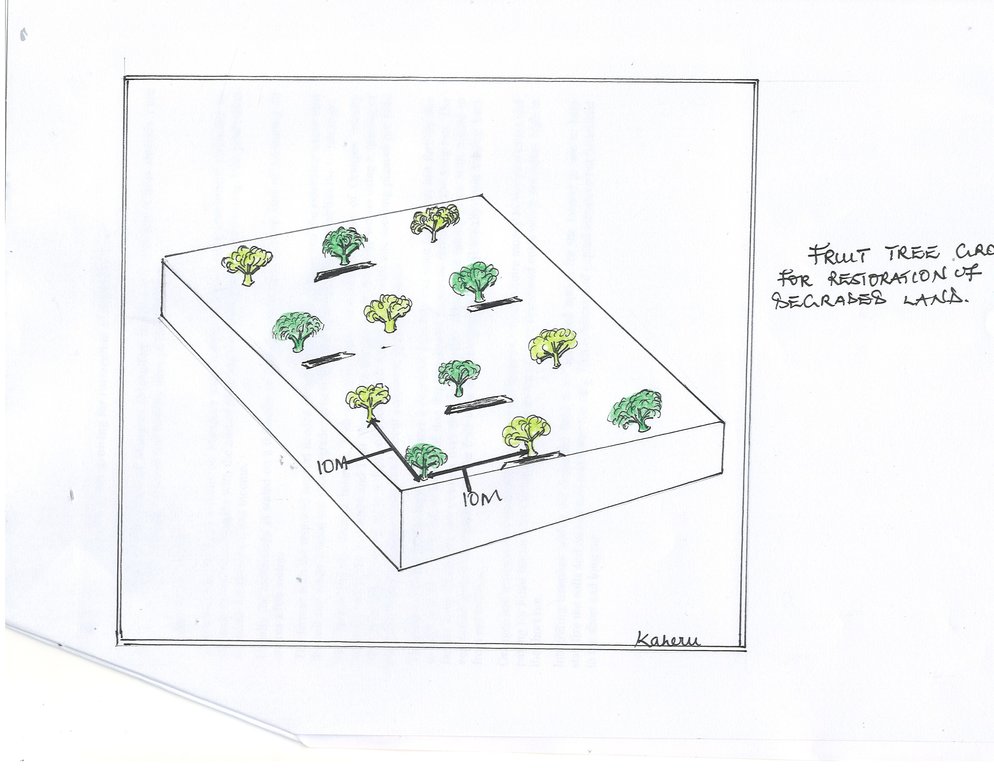Fruit tree growing for restoration of degraded lands [乌干达]
- 创建:
- 更新:
- 编制者: Kamugisha Rick Nelson
- 编辑者: JOY TUKAHIRWA, Richard Otto Kawawa, Sunday Balla Amale, Bernard Fungo
- 审查者: Donia Mühlematter, Drake Mubiru, Nicole Harari, Renate Fleiner, Stephanie Jaquet
technologies_2821 - 乌干达
查看章节
全部展开 全部收起1. 一般信息
1.2 参与该技术评估和文件编制的资源人员和机构的联系方式
关键资源人
土地使用者:
Acen Constance
有助于对技术进行记录/评估的项目名称(如相关)
Scaling-up SLM practices by smallholder farmers (IFAD)有助于对技术进行记录/评估的机构名称(如相关)
CDE Centre for Development and Environment (CDE Centre for Development and Environment) - 瑞士1.3 关于使用通过WOCAT记录的数据的条件
编制者和关键资源人员接受有关使用通过WOCAT记录数据的条件。:
是
1.4 所述技术的可持续性声明
这里所描述的技术在土地退化方面是否存在问题,导致无法被认为是一种可持续的土地管理技术?:
否
2. SLM技术的说明
2.1 技术简介
技术定义:
Fruit trees of Mangoes (Mangifera indica) and Oranges (Citrus sinensis) are grown on degraded land to improve soil fertility through deep soil nutrient mining and litter of leaves.
2.2 技术的详细说明
说明:
Fruit tree growing, with focus on mangoes and oranges, is a rewarding investment promoted by farmers in Northern Uganda with the aim of increasing fruit production for home consumption and income, and restoration of degraded land. On a farm located on a steep slope and measuring 40m x 100m (i.e. 1 acre), the land user select and plant disease tolerant, high yielding and marketable orange varieties (e.g. Valencia and Anlin) and mango varieties (Apple and Tommy) using spades, hoes, and pangas to excavate and dig up planting holes, 30 cm deep, with fruit trees planted at a spacing of 10 m ×10 m, during the rainy season; with 7 Cows, 5 goats and 4 sheep kept animal manure provision to apply on the technology using hired labour and supported by family labour. After establishment, the farmer keeps on observing the changes over time to see what is taking place with regard to vegetation growth, performance of fruit trees and how the visible soil properties are changing e.g. the colour showing a black sign of organic matter built up and soil health improvement.
Oranges and mangoes are susceptible to pests and diseases, which require money to buy pesticides and paying, as well as for hired labour for spraying. The farmer needs to be aware of these associated costs, which are rather high after establishment. Efforts by the farmer to integrate trenches within the degraded field is an additional option for the farmer to help enhance soil and water conservation by reducing water runoff. This is labour and capital intensive but beneficial in the short and long run.
2.3 技术照片
2.4 技术视频
注释、简短说明:
Fruit tree growing for soil and water conservation in Amuru district.
日期:
15/12/2017
位置:
Amuru district, Northern Uganda
摄影师的名字:
Issa Kasozi and Mark
2.5 已应用该技术的、本评估所涵盖的国家/地区/地点
国家:
乌干达
区域/州/省:
Northern Region,Uganda
有关地点的进一步说明:
Gulu District
具体说明该技术的分布:
- 均匀地分布在一个区域
如果不知道精确的区域,请注明大致覆盖的区域:
- < 0.1 平方千米(10 公顷)
Map
×2.6 实施日期
注明实施年份:
2015
如果不知道确切的年份,请说明大概的日期:
- 不到10年前(最近)
2.7 技术介绍
详细说明该技术是如何引入的:
- 通过土地使用者的创新
- 通过项目/外部干预
注释(项目类型等):
It was supported by the extension worker with advisory services on how to plant and space.
3. SLM技术的分类
3.1 该技术的主要目的
- 改良生产
- 减少、预防、恢复土地退化
- 创造有益的经济影响
3.4 供水
该技术所应用土地的供水:
- 雨养
3.5 该技术所属的SLM组
- 农畜综合管理
- 改良植物品种/动物品种
3.6 包含该技术的可持续土地管理措施

农艺措施
- A1:植被和土壤覆盖层
- A2:有机质/土壤肥力
- A5:种子管理,改良品种

植物措施
- V1:乔木和灌木覆盖层

结构措施
- S11:其它

管理措施
- M1:改变土地使用类型
- M2:改变管理/强度级别
- M3:根据自然和人文环境进行布局
- M6:废物管理(回收、再利用或减少)
注释:
S11: Trenshes.
3.7 该技术强调的主要土地退化类型

土壤水蚀
- Wt:表土流失/地表侵蚀
- Wg:冲沟侵蚀/沟蚀

土壤风蚀
- Et:表土流失
- Ed:风蚀风积

化学性土壤退化
- Cn:肥力下降和有机质含量下降(非侵蚀所致)

生物性退化
- Bc:植被覆盖的减少
- Bh:栖息地丧失
- Bq:数量/生物量减少
- Bs:质量和物种组成/多样性的下降
3.8 防止、减少或恢复土地退化
具体数量名该技术与土地退化有关的目标:
- 防止土地退化
- 修复/恢复严重退化的土地
4. 技术规范、实施活动、投入和成本
4.1 该技术的技术图纸
4.2 有关投入和成本计算的一般信息
具体说明成本和投入是如何计算的:
- 每个技术区域
注明尺寸和面积单位:
0.5 acres
其它/国家货币(具体说明):
UGX
如相关,注明美元与当地货币的汇率(例如1美元=79.9巴西雷亚尔):1美元=:
3400.0
注明雇用劳工的每日平均工资成本:
5000
4.3 技术建立活动
| 活动 | 时间(季度) | |
|---|---|---|
| 1. | Site selection/ degraded area | Once before planting / during dry season |
| 2. | Look for required labour and in puts | Once before planting /during dry season |
| 3. | Select nutrient fixing, high yiedling and marketable varieties | Once before planting / during dry season |
| 4. | Transport the varieties to the field | On set of rains |
| 5. | Diging the holes | On set of rains |
| 6. | Planting using labour | During rainy season |
| 7. | Watering in case of drought. | During the dry season |
4.4 技术建立所需要的费用和投入
| 对投入进行具体说明 | 单位 | 数量 | 单位成本 | 每项投入的总成本 | 土地使用者承担的成本% | |
|---|---|---|---|---|---|---|
| 劳动力 | persons days / monthly basis | Persons | 5.0 | 150000.0 | 750000.0 | 1000.0 |
| 设备 | Hoe | Pieces | 5.0 | 10000.0 | 50000.0 | 100.0 |
| 设备 | Pangas | Pieces | 3.0 | 7000.0 | 21000.0 | 100.0 |
| 设备 | watering can | Pieces | 2.0 | 5000.0 | 10000.0 | 100.0 |
| 植物材料 | Seedlings | kgs | 1000.0 | 2500.0 | 2500000.0 | 100.0 |
| 其它 | Transport for seedlings | Lorry | 2.0 | 100000.0 | 200000.0 | |
| 技术建立所需总成本 | 3531000.0 | |||||
注释:
More costs on seedlings during establishment.
4.5 维护/经常性活动
| 活动 | 时间/频率 | |
|---|---|---|
| 1. | Watering | Daily, dry season |
| 2. | Weeding | Twice a year, wet and dry season |
4.6 维护/经常性活动所需要的费用和投入(每年)
| 对投入进行具体说明 | 单位 | 数量 | 单位成本 | 每项投入的总成本 | 土地使用者承担的成本% | |
|---|---|---|---|---|---|---|
| 劳动力 | Labour for watering (monthly) | persons | 2.0 | 150000.0 | 300000.0 | 100.0 |
| 劳动力 | Labour for weeding (monthly) | persons | 2.0 | 150000.0 | 300000.0 | 100.0 |
| 技术维护所需总成本 | 600000.0 | |||||
4.7 影响成本的最重要因素
描述影响成本的最决定性因素:
Labour for planting , weeding and watering on monthly basis.
5. 自然和人文环境
5.1 气候
年降雨量
- < 250毫米
- 251-500毫米
- 501-750毫米
- 751-1,000毫米
- 1,001-1,500毫米
- 1,501-2,000毫米
- 2,001-3,000毫米
- 3,001-4,000毫米
- > 4,000毫米
指定年平均降雨量(若已知),单位为mm:
1500.00
有关降雨的规范/注释:
Two rainy and two dry seasons - Bimodal rainfall.
农业气候带
- 半湿润
5.2 地形
平均坡度:
- 水平(0-2%)
- 缓降(3-5%)
- 平缓(6-10%)
- 滚坡(11-15%)
- 崎岖(16-30%)
- 陡峭(31-60%)
- 非常陡峭(>60%)
地形:
- 高原/平原
- 山脊
- 山坡
- 山地斜坡
- 麓坡
- 谷底
垂直分布带:
- 0-100 m a.s.l.
- 101-500 m a.s.l.
- 501-1,000 m a.s.l.
- 1,001-1,500 m a.s.l.
- 1,501-2,000 m a.s.l.
- 2,001-2,500 m a.s.l.
- 2,501-3,000 m a.s.l.
- 3,001-4,000 m a.s.l.
- > 4,000 m a.s.l.
说明该技术是否专门应用于:
- 凸形情况
5.3 土壤
平均土层深度:
- 非常浅(0-20厘米)
- 浅(21-50厘米)
- 中等深度(51-80厘米)
- 深(81-120厘米)
- 非常深(> 120厘米)
土壤质地(表土):
- 中粒(壤土、粉土)
土壤质地(地表以下> 20厘米):
- 中粒(壤土、粉土)
表土有机质:
- 中(1-3%)
5.4 水资源可用性和质量
地下水位表:
< 5米
地表水的可用性:
中等
水质(未处理):
不良饮用水(需要处理)
水的盐度有问题吗?:
否
该区域正在发生洪水吗?:
否
5.5 生物多样性
物种多样性:
- 低
栖息地多样性:
- 低
5.6 应用该技术的土地使用者的特征
定栖或游牧:
- 定栖的
生产系统的市场定位:
- 混合(生计/商业)
非农收入:
- 收入的10-50%
相对财富水平:
- 平均水平
个人或集体:
- 个人/家庭
机械化水平:
- 手工作业
性别:
- 女人
- 男人
土地使用者的年龄:
- 青年人
- 中年人
说明土地使用者的其他有关特征:
The land user is a secondary school teacher as a source of livelihood.
5.7 应用该技术的土地使用者使用的平均土地面积
- < 0.5 公顷
- 0.5-1 公顷
- 1-2 公顷
- 2-5公顷
- 5-15公顷
- 15-50公顷
- 50-100公顷
- 100-500公顷
- 500-1,000公顷
- 1,000-10,000公顷
- > 10,000公顷
这被认为是小规模、中规模还是大规模的(参照当地实际情况)?:
- 小规模的
注释:
0.5 acres of land not planted all due to the high cost of seeds and labour.
5.8 土地所有权、土地使用权和水使用权
土地所有权:
- 个人,未命名
土地使用权:
- 个人
用水权:
- 个人
注释:
Bought the land using a loan that he acquired from the bank.
5.9 进入服务和基础设施的通道
健康:
- 贫瘠
- 适度的
- 好
教育:
- 贫瘠
- 适度的
- 好
技术援助:
- 贫瘠
- 适度的
- 好
就业(例如非农):
- 贫瘠
- 适度的
- 好
市场:
- 贫瘠
- 适度的
- 好
能源:
- 贫瘠
- 适度的
- 好
道路和交通:
- 贫瘠
- 适度的
- 好
饮用水和卫生设施:
- 贫瘠
- 适度的
- 好
金融服务:
- 贫瘠
- 适度的
- 好
Security:
- 贫瘠
- 适度的
- 好
6. 影响和结论性说明
6.1 该技术的现场影响
社会经济效应
生产
作物生产
注释/具体说明:
From the sale of fruits.
作物质量
注释/具体说明:
Good due to litter / green leaves.
土地管理
注释/具体说明:
Use of fruit trees are good at restoring degraded areas.
收入和成本
农业投入费用
注释/具体说明:
Purchase of hoes, pangas and spades.
农业收入
注释/具体说明:
From the sale of fruits.
工作量
注释/具体说明:
Watering and weeding.
社会文化影响
食品安全/自给自足
注释/具体说明:
Not yet harvested
SLM/土地退化知识
注释/具体说明:
Trainings on fruit farming and management by extension agents and fellow farmers.
生态影响
土壤
土壤水分
注释/具体说明:
Due to the grass covert that minimize the evapotranspiration.
土壤覆盖层
注释/具体说明:
No cultivation/ allow grass to grow.
土壤流失
注释/具体说明:
Fruit trees stabilize the soils.
土壤有机物/地下C
注释/具体说明:
Due to the mulch decomposition.
生物多样性:植被、动物
植被覆盖
注释/具体说明:
Growing under the planted fruit trees.
6.3 技术对渐变气候以及与气候相关的极端情况/灾害的暴露和敏感性(土地使用者认为的极端情况/灾害)
渐变气候
渐变气候
| 季节 | 增加或减少 | 该技术是如何应对的? | |
|---|---|---|---|
| 年温度 | 增加 | 好 | |
| 季节性温度 | 湿季/雨季 | 增加 | 适度 |
| 年降雨量 | 减少 | 好 | |
| 季雨量 | 湿季/雨季 | 减少 | 好 |
气候有关的极端情况(灾害)
生物灾害
| 该技术是如何应对的? | |
|---|---|
| 昆虫/蠕虫侵扰 | 适度 |
6.4 成本效益分析
技术收益与技术建立成本相比如何(从土地使用者的角度看)?
短期回报:
稍微积极
长期回报:
非常积极
技术收益与技术维护成本/经常性成本相比如何(从土地使用者的角度看)?
短期回报:
轻度消极
长期回报:
积极
注释:
Slightly Negative: More costs on labour and inputs.
Very positive: Very positive returns in improving fertility due to leaves litter.
6.5 技术采用
- 1-10%
如若可行,进行量化(住户数量和/或覆盖面积):
5
在所有采用这项技术的人当中,有多少人是自发的,即未获得任何物质奖励/付款?:
- 0-10%
6.6 适应
最近是否对该技术进行了修改以适应不断变化的条件?:
否
6.7 该技术的优点/长处/机会
| 土地使用者眼中的长处/优势/机会 |
|---|
| Appropriate for both small and large scale land users. |
| Can be replicated and be promoted by other land users. |
| Cost effective: Invest in more money at the establishment and earn more benefits (restoration of degraded areas, income, soil fertility improvement, employment and fruits for home consumption and sale). |
| 编制者或其他关键资源人员认为的长处/优势/机会 |
|---|
| The technology is appreciated by the farmer and this is a sign of ownership - sustainability. |
6.8 技术的弱点/缺点/风险及其克服方法
| 土地使用者认为的弱点/缺点/风险 | 如何克服它们? |
|---|---|
| Very laborious (planting, wedding and watering). | Use family labour. |
| Very expensive - buying seedlings and hire of labour. | Join savings groups that give loans at low interest rates (3%). |
| Benefits are realized after a long period. | The land user can look for alternative sources of income to supplement the technology. Engage in selling seedlings as a business to those who may want to start establishing this technology. |
| 编制者或其他关键资源人员认为的弱点/缺点/风险 | 如何克服它们? |
|---|---|
| No integration with other agroforestry trees for fodder yet as the land user has livestock. | The technology need to be integrated with agroforestry trees (callindra, Grivellea ) for fodder since the land user has livestock. |
7. 参考和链接
7.1 信息的方法/来源
- 实地考察、实地调查
01
- 与土地使用者的访谈
01
(现场)数据是什么时候汇编的?:
24/05/2017
链接和模块
全部展开 全部收起链接
无链接
模块
无模块


